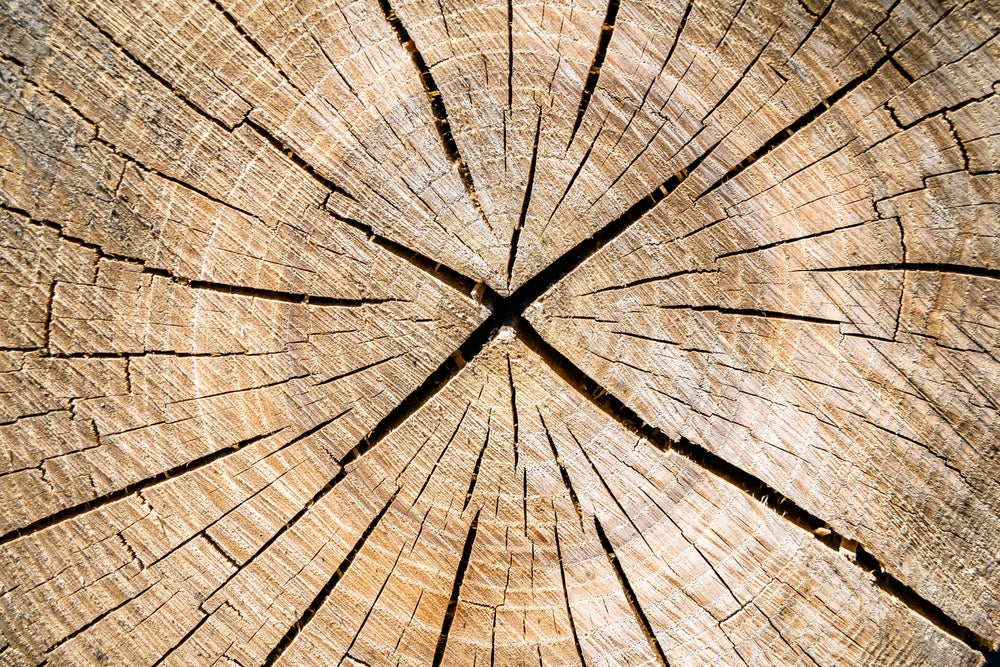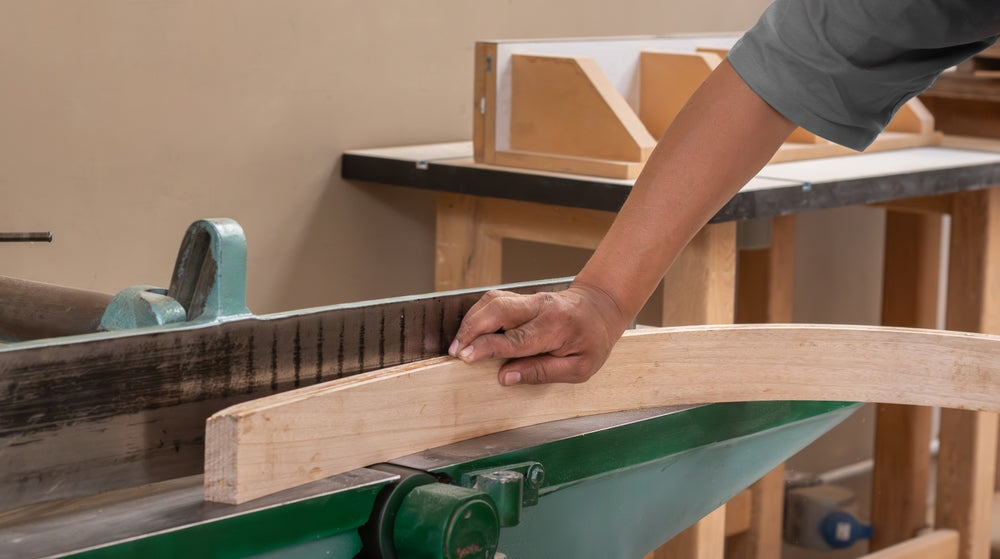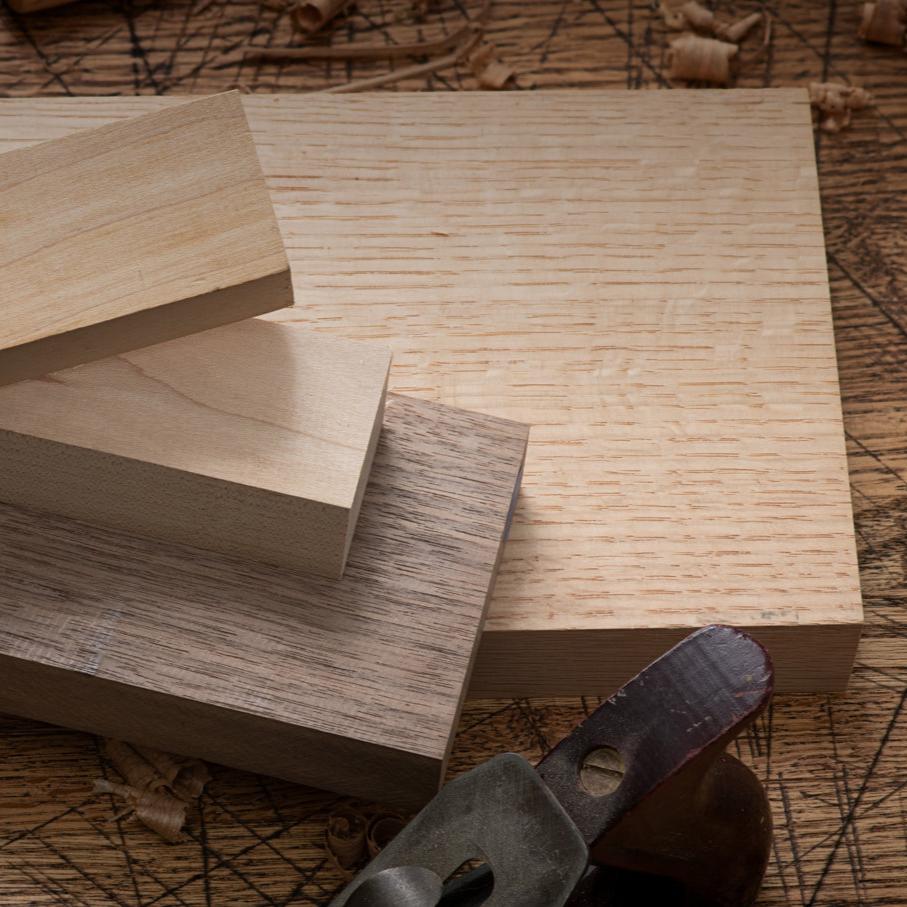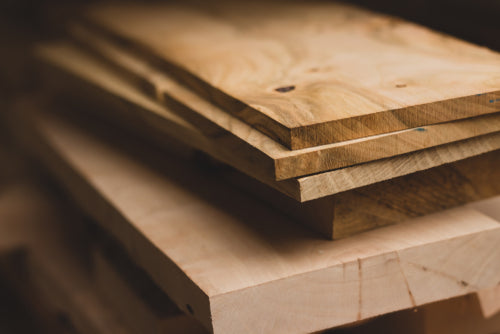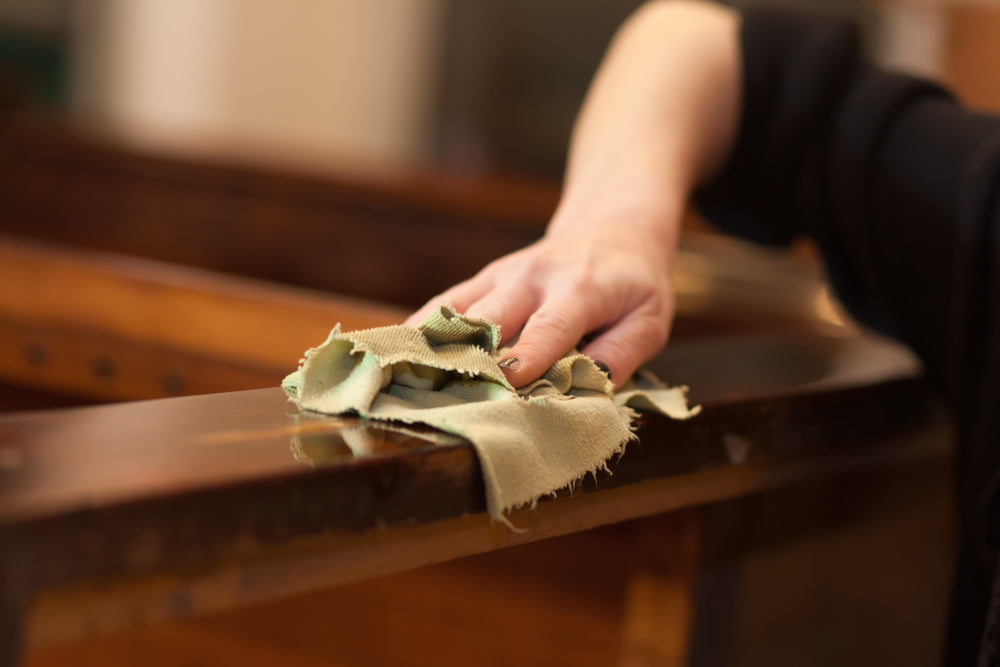What are some common lumber defects? Well, there are seemingly endless terms to describe irregularities and flaws in a piece of wood. Some add character, while others cause serious issues, severely reducing the yield of the material.
Any woodworker knows that a high-quality project is only possible with high-quality materials, so it’s important to know which defects are of concern. In this guide, we’ll talk about many common wood defects and how they affect lumber.
What Causes Wood & Lumber Defects?
No two pieces of wood are alike. A single tree can differ drastically from each of its neighbors, just as different cuts of lumber from the same tree can display totally contrasting characteristics.
The life of a tree and the process of turning it to lumber can produce a wide array of irregularities in the finished lumber that are referred to as defects. Keep reading to learn more about these features, their causes, and how to spot them.
Natural Elements
As a natural material, wood’s quality is greatly influenced by the environment it grows in. Many of the most common defects in lumber are caused by natural conditions rather than harvesting or processing. Factors like growth patterns, fungal infection, and animal damage can all be expressed in the lumber produced from a given tree.
Not all defects are negative, however - a handful are prized for the unique character they create in finished lumber products.
Conversion
Harvesting lumber from trees is much more complex than simply cutting them down. Numerous cuts are required to fell a tree and convert its trunk to useful lumber, and each step of this long and complex process can introduce new defects.
Heavy machinery, saw blades, and moving equipment can all introduce undesirable defects.
SeasoningThe process of drying freshly cut wood, or seasoning, is one of the most important aspects of lumber production. When a tree is felled, its wood contains a substantial amount of moisture.
Water must be allowed to evaporate out of the wood before it can be further refined into dimensional lumber. To achieve this, sawmills cut logs into slabs and dry them rapidly in a heated kiln or slowly in open air.
However, changing a piece of wood’s moisture content causes it to swell or shrink, which introduces internal stresses. As these stresses build up, a variety of defects that affect the lumber’s shape and strength can appear.
Wood Defects from Natural Elements
While natural defects can affect both the strength and beauty of wood, the typical woodworker is most concerned with the aesthetic changes they bring. Natural defects tend to alter a piece of lumber’s grain, so be sure to brush up on your wood grain knowledge and how to make the most of different grains with finishes. Read on to learn about the most common natural lumber flaws.
Pockets in Bark
As a tree grows and forms forks or new limbs, its bark must adjust to the new shape. Occasionally, the tree trunk grows around a section of bark, including it in the wood and creating a knot-like internal pocket of bark. Bark pockets can diminish the appearance and strength of finished lumber that includes them.
Bird Pecks
Birds such as woodpeckers and yellow-bellied sapsuckers commonly peck holes in trees as part of their feeding habits.
While single small holes may not have an effect, extensive pecking alters the grain pattern of the wood and can allow bark pockets to form. As a result, bird pecks often appear as dark spots in the finished lumber’s grain.
This defect is especially destructive in hickory, where even light pecking damage produces dark streaks.
Burls
When a tree is damaged or infected by a disease, bulbous growths called burls can occur.
Burls are the result of numerous dormant buds growing together, which produces a disorderly and striking grain pattern that is often prized for its unique and extreme figure. Redwood and walnut trees are especially prone to burl formation.
Coarse & Raised Grain
In many species, wood that grows in the summer is harder than springtime growth. This means that part of the grain is softer and easier to compress when the lumber is processed.
Lumber with this defect can have a coarse, ridged grain that is unsuitable for applications that require a uniform, smooth surface.
Damage from Fungus
Fungal attack is among the most common types of natural wood damage. In fact, the rotting process is actually the result of fungi infecting and digesting wood. Wood decay can be caused by soft rot, brown rot, and white rot fungi.
Soft rot attacks excessively moist wood, and can often be introduced if improperly stored lumber is repeatedly exposed to rain. The wood’s cellulose is broken down by fungal enzymes, a process that softens it and reduces its strength. Lumber that has been attacked by soft rot will often become weak, spongy, and discolored.
Brown rot is the correct term for what is often referred to as dry rot. It attacks both the cellulose and hemicellulose in wood, causing it to crack across the grain and crumble into roughly cubical pieces.
Brown rot naturally occurs in northern regions or high elevations, making it more common on the softwood species native to such climates.
The term dry rot is misleading, as all wood decay fungi require moisture. However, lumber affected by brown rot can dry out and still suffer from the effects of the original attack.
White rot is caused by fungi that decompose cellulose, hemicellulose, and lignin wood. It can easily be identified by the white coloration and bleaching it leaves on affected lumber.Like other rot fungi, white rot reduces the strength and hardness of wood it attacks.
Damage from Insects
A wide array of insects require trees for their life cycles, and often cause damage as a result.
The most notable of these are termites, insects known for both living in and eating wood. As they expand their nests, these destructive pests create vast networks of tunnels throughout a tree while leaving the outermost surface intact. Of course, this ruins both the aesthetics and strength of the affected wood, making it unusable for lumber.
Wood-boring beetles, which tunnel into wood to create nests and lay eggs, are another group of insects responsible for causing defects. The larvae of some species consume parts of the wood as they grow, while others simply excavate tunnels as living spaces.
While these insects generally prefer stressed living trees, many will attack cut lumber if it is available. Wood that has been attacked by borers is weakened and prone to rot.
Both termites and boring beetles are drawn to moist or rotting wood, so proper storage and finishing can go a long way towards keeping them out.
Knots
Perhaps the best-known natural lumber defect is the presence of knots. Whenever a branch growing from a tree’s main trunk is broken off or removed, the piece left behind remains attached.
As the tree grows and its trunk widens, the branch stub is absorbed into the new wood. The result is a knot - a dark circle with properties that are totally different from the surrounding wood.
If the branch stub remains alive as it is absorbed, a solid knot is formed. Solid knots are much harder and darker than the nearby wood, but they are firmly attached to it.
If the branch stub dies off before it is absorbed, then a loose knot is formed. Because they are composed of dead material, loose knots are not strongly attached to the nearby wood and can easily be knocked out.
Removing solid or loose knots leaves a hole in the affected lumber, which generally reduces its usefulness and strength. In some cases, knots can be left intact to produce a rustic appearance in the finished product.
Shake
When the wood within a tree separates along the grain, an internal crack called a shake is formed. This defect is impossible to identify before a tree is felled, so its effects are often only seen after a log has been processed into lumber.
The root cause of shakes is a specific type of bacteria that infects trees and weakens the wood within the trunk. This allows environmental events such as high winds, extreme cold, and impact from felling to create internal cracks in the wood.
The most common types of shake are ring, star, and heart shakes.
A ring shake occurs when two adjacent growth rings separate, producing a curved or cupped crack.
A star shake is produced by splitting along the log’s rays, and consists of several cracks running across growth rings from the outer edge of the log towards its center.
Finally, a heart shake occurs when cracks form within the heartwood and spread radially outwards towards the outer edge of the log.
In finished lumber, shakes can be significant defects that reduce a piece’s strength and usefulness for structural projects.
Splits
If a crack in a piece of lumber extends from one face to the opposite one, it can be considered a split.
Although many splits are the result of pre-existing shakes, they can also be introduced by external factors such as impact. Like shakes, splits can seriously reduce the strength of affected lumber.
Stains & Spalting
Marks, lines, or color changes displayed on a piece of lumber are typically referred to as spalting.
When white rot fungus colonizes wood, it creates bleached areas that can produce unique patterns when finished.
Other fungi can also colonize wood and leave coloration patterns called blue stain or sap stain. As they move inwards from the outer surface of a tree, the fungal colonies produce pigments that leave dark blue patterns within the wood. While these fungi can eventually degrade the wood, they tend to act much slower than rot fungi do.
Stain and spalting defects are often considered desirable by woodworkers for the unique figure they grant to the finished lumber. However, the patterns are usually accompanied by some form of decay, so wood with these defects is best used for decorative purposes.
Wandering Hearts
Trees growing in environments with frequent or sustained high winds are prone to developing wandering hearts. This defect occurs when a tree’s heart does not remain centered in the trunk as it grows, leading to highly irregular grain.
Wandering hearts cause frequent changes in grain direction along the length of the log, resulting in dimensionally unstable lumber that is not useful for most projects.
Wood Defects Caused by Conversion
Conversion, or processing timber into dimensional lumber, involves the use of industrial-scale planers and other tools. Keep reading to learn more about the defects these machining processes can introduce.
Chip Marks
After rough dimensional cuts are made, pieces of lumber are often planed to specific thicknesses. When a chip of wood being machined away by the planer sticks to the tool, it can be pressed into the surface of the lumber and leave an indentation. This defect interrupts the smooth surface of planed pieces, reducing their quality.
Torn Grain
As a cutting tool travels along a piece of lumber’s surface, sections of the wood below the cutting line can be torn away. The result is an uneven face and a disruption in the grain pattern referred to as torn grain or tearout.
Diagonal Grain
If a log is sawn at an angle, the lumber produced will have edges that are not parallel with the grain. This defect, called diagonal grain, weakens lumber and prevents it from being used in many structural applications.
Wane
Lumber cut from the outer edges of a log will have rounded corners or faces due to the log’s curvature. In some cases, bark may even be attached. The presence of these features is called wane, and it can reduce the usefulness of dimension lumber.
Machine Bite, Burn, or Gouge
A variety of defects can be caused by machining errors or accidents during conversion. Scores or depressions where the planer’s cutting knives exit the workpiece are referred to as machine bite.
If the cutting tool overheats, it can leave dark burn marks on the wood that interfere with its natural appearance.
Cutting tools that deviate below the intended cutting surface create grooves called machine gouges. While these defects typically do not affect strength, they can seriously reduce the attractiveness of a piece of lumber.
Wood Defects from Seasoning
Seasoning, or drying freshly cut timber, is a crucial stage of lumber production. If not done with care, it can lead to a bending and cracking of the wood. Even once it has left the lumberyard, wood can exchange moisture with the surrounding air and change shape, so be sure to read up on proper storage techniques before your next big lumber purchase, and keep reading to learn more about the defects that can occur during the seasoning process.
Bowing
Bowing is a gradual curvature along the length of a piece of lumber that makes it resemble a curved bow used for archery. A variety of causes can contribute to bowing, including poor support in storage or uneven drying during seasoning.
Frequent changes in humidity (and therefore wood moisture content) can create bowed lumber. This defect can render some lumber useless, especially if long, straight pieces are required.
Checks
If a piece of wood is dried too quickly, cracks can form due to stresses from uneven shrinkage. A crack that is visible from one surface of a board but does not extend completely through it is called a check.
Crooks & Spring
A crook, also called spring, occurs when a flat piece lumber curves laterally along its length. This can be visualized as a flat road with a gradual turn in it.
As with many other warping defects, crooks are typically caused by moisture fluctuations and uneven drying. Minor cases can be corrected by trimming, but the majority of crooked lumber is not usable.
Twisting
When two or more of the previously mentioned curvature defects are present in a board, it may be considered twisted. Pieces of lumber with twist are not straight in any direction, and cannot be used for the majority of woodworking purposes.
Cupping
Curvature across the width of a board that makes one face concave and the opposite one convex is called cupping. It most commonly occurs when flat sawn lumber shrinks unevenly during the drying process. Cupped lumber is difficult to use for many projects due to its curved shape.
Case Hardening
During the drying process, a piece of wood’s outer surfaces reject moisture to the surrounding air.
Water in the piece’s interior, however, must work its way to the surface in order to evaporate. If the surface faces dry too quickly, they can shrink around the still-moist interior wood and compress it.
This defect, referred to as case hardening, results in internal stresses that are not relieved until the lumber is cut. Case-hardened lumber can appear straight at first, but warp severely once it is sawn.
Honeycombing
The development of a network of internal cracks within a piece of lumber during drying is referred to as honeycombing.
If case hardening becomes severe, stresses inside the wood lead to an array of cracks with a honeycomb-like appearance. Honeycombing is not visible from the outside, so it cannot be identified until lumber is cut after drying.
Choose Your Material & Get Started on Your Project Today!
Now that you know about the wide range of defects in lumber, avoid them by sourcing your next project from North Castle Hardwoods. We are proud to offer quality hardwood lumber in a range of sizes to suit your needs. We use custom grading rules to ensure that our premium dimensional lumber adheres to strict standards, so you can rest assured that your work will benefit from top-notch materials. Got questions or custom requirements? Contact us today!
